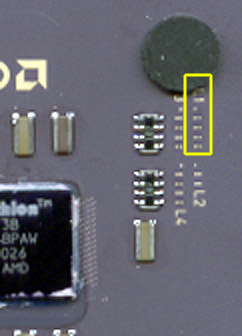AMD Athlon "Thunderbird" 1.2GHz & Duron 800MHz
by Anand Lal Shimpi on October 17, 2000 12:56 AM EST- Posted in
- CPUs
Overclocking
Both the Athlon and the Duron are still able to be overclocked through the manipulation of their clock multipliers as well as FSB frequencies, the easiest being the former. For information on how to "unlock" your CPUs read our quick one page tutorial on it.
Basically you need to check the status of the L1 "bridges" on your CPU, if the points on the left are connected to their counterparts on the right then your CPU is unlocked, all you need is a motherboard to adjust the multiplier and you'll be set. If these points aren't connected, then you need to connect them, preferably with a very careful application of some conductive ink or epoxy. Doing so will unlock your CPU, leaving the rest up to the motherboard to handle.

The 1.2GHz Athlon is in a bit of a situation from an overclocking standpoint, with the highest multiplier defined on the CPU being 12.5x, the highest you can get the CPU to go at its default 100MHz DDR FSB is 1.25GHz, not too impressive. Obviously when combined with a higher FSB setting you'll be able to push it even higher, but this CPU won't be the best for those interesting in overclocking.
The Duron 800 is also not the best overclocking candidate as it is still using Aluminum interconnects. From what we've seen, only the Copper based cores from Dresden are really able to hit 1GHz and beyond reliably and on a large enough scale. While there may be some Aluminum cores to hit 1GHz, for the most part it seems like it'll take a Fab30 produced Duron to be a truly solid overclocker beyond what the current Durons are capable of reaching.
So as far as the Duron is concerned, chances are that the 800MHz parts won't get any higher than the 700MHz parts we've had around for the past couple of months. Meaning that 900 - 950MHz is the realistic max without getting into some more powerful cooling methods.










0 Comments
View All Comments